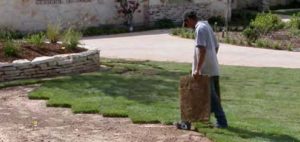Benefits of Lawns
Lawns in the home landscape serve many important functions. They are outdoor carpets that provide a soft surface for children and pets to play. They moderate temperatures and capture rainfall reducing runoff and erosion. That said, with growing concerns about future water supply, turf’s place in our landscape has been called into question. If you decide to keep turf in all or part of your landscape, much can be done to minimize the water needs of your lawn.
Choosing What to Plant

Laying sod to establish turf
Planting native turf mixes (typically a combination of Buffalo and Blue Grama) is a great water-wise option, although you should make sure you like the look and feel. Otherwise, we can choose from a number of species that vary in their drought tolerance and light requirements. Each has its place, including Buffalograss for a sunny natural setting with minimal mowing or watering, various Zoysiagrass varieties in sun to part shade, Bermudagrass in sunny areas where traffic is heavy, and St. Augustinegrass in part sun to shade where its water needs are dramatically reduced. The AggieTurf website has additional information on the recommended varieties for Texas. More tips for improving lawns in shade can be found here.
Best Planting Method
If you are going to establish a new lawn, the species you choose will dictate the best planting method. Turfgrass can be established by seed, sod, sprigs, or plugs, but not all may be available to purchase. Please see Table 1. Turfgrass establishment methods suited to or available for use in Texas.
Reduce Water and Maintenance
Ever-increasing water use restrictions will result in landscape design in which turfgrasses are focused on the areas where the family gathers to relax and play. Proper soil preparation, efficient cycle-and-soak irrigation and appropriate mowing height all help reduce the amount of water it takes to keep turf healthy and attractive. When we provide proper care, water quality and quantity concerns are minimized as are some diseases and insect problems.
How to Water Your Lawn
The EPA estimates that in dry climates like that of Central Texas, a household’s outdoor water use can exceed the amount of water used for all other residential purposes. During the summer, the pressure on available water means that many communities in Central Texas are faced with water restrictions. Watering efficiently will help reduce the amount of water you need to save your lawn. Texas A&M AgriLife Research recommends cycle-and-soak irrigation as a best practice and includes other helpful tips for maintaining your landscape.
How Much to Fertilize Your Lawn
The best way to determine how much fertilizer to add is to get your soil tested. The dry conditions, warm nights, and varying soil depths of the Austin area means that much of the standard advice you get may not apply to your lawn. It’s best to get your soil tested so that you know the exact amount to apply to your unique growing conditions. Please visit the Texas AgriLife Extension Service Soil, Water and Forage Testing Laboratory. Fill out their Urban and Homeowner Soil Sample Information Form. Sampling instructions are included. Over fertilization can lead to other problems like disease vulnerability and diminished drought tolerance. The City of Austin Watershed Department has several publications on lawn management as part of their Grow Green partnership with AgriLife Extension. You can find the fact sheets on their website and at many landscape nursery businesses in Travis County.
Lawn Weeds
A typical lawn is often the only monoculture space in our landscape. Other plants invading this special space are classified as weeds. Weed management begins with proper identification since prevention and removal are dependent on the type of plant in question. AggieTurf is an excellent resource for identifying turfgrass weeds and organizing them into groups: Broadleaf Weeds, Grasses and Grass-like Weeds, and Sedges. Identifying weeds by this method is important because herbicide effectiveness is often listed by group classification.
Lawn Pests
Insects, worms, and other bugs provide our landscapes numerous benefits, including pollination, decomposing organic residues, and aeration of compacted soil. This is why it’s important to identify exactly which pest needs to be controlled so harm doesn’t befall the beneficial creatures we depend upon. AggieTurf classifies pests according to the habitat in which the pest spends most of its life. This method helps target the treatment and prevention methods. Their website describes the life cycle and control recommendations.
Mowing Heights
The following are the recommended mowing heights from AggieTurf for rotary mowers. Click on each link for more information on reel mowers or other factors. In summer, mowers should be set at the high end of the range.
- Bermudagrass: 1 to 2 inches
- Buffalograss: 2.5 to 4 inches
- St. Augustinegrass: 2.5 to 3.5 inches
- Zoysiagrass: 1 to 2 inches
Simple Steps to Lawn Care
Lawns don’t have to be difficult, even when faced with water restrictions. Follow these simple steps to achieve success.
- Give your lawn a great soil
- Choose the right turfgrass
- Mow at the right height
- Train roots to grow deep through proper irrigation
- Aerate compacted spots
- Fertilize only when needed and according to soil test results
Additional Resources for Lawns
Lawn Fertilizer Calculator (based off your soil test results from Texas A&M)
Lawn Square Footage Calculator
Fertilizer Spreader Calibration
Grow Green Plant Guides – Lawn Care, Lawn Problems, from City of Austin Watershed Department
Grow Green Lawn Fertilizer Recommendations, from City of Austin Watershed Department
